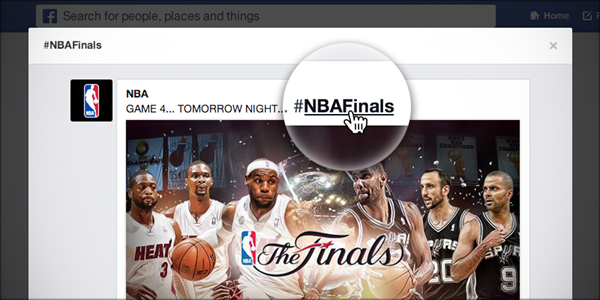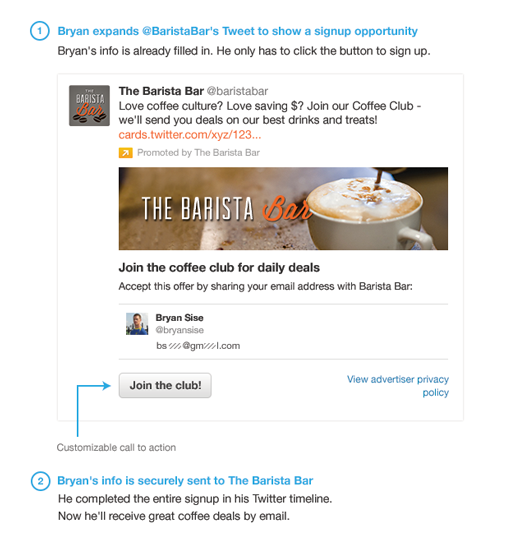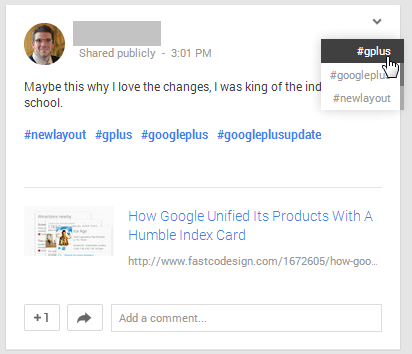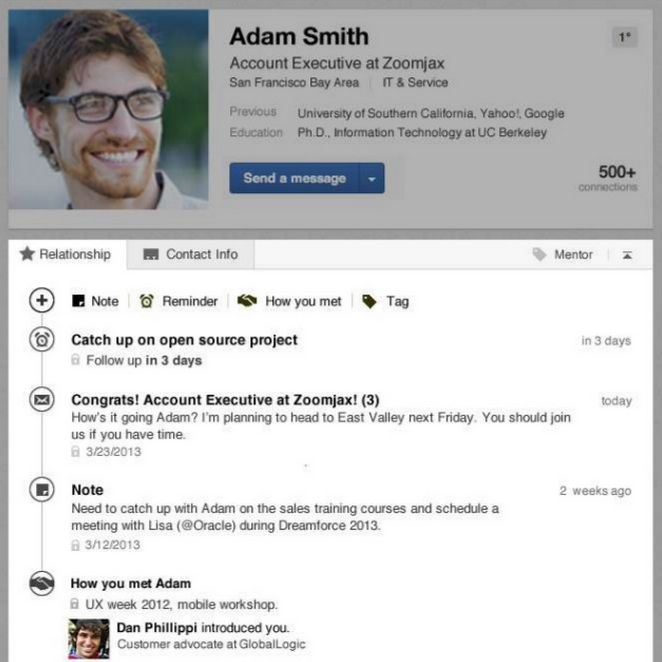A Year in Review: The Biggest Social Media Updates of 2013
by Maggie Hibma

December 11, 2013 at 11:00 AM
39
inShare
inShare
 Can you believe 2013 is almost over? Well, it is, meaning it's that time of year again to startplanning for the year ahead and thinking about everything you want your marketing to achieve -- more leads, more website traffic, you name it. But it's tough to look forward without understanding what's happened this year.
Can you believe 2013 is almost over? Well, it is, meaning it's that time of year again to startplanning for the year ahead and thinking about everything you want your marketing to achieve -- more leads, more website traffic, you name it. But it's tough to look forward without understanding what's happened this year.
That's why it's important to not only analyze your own marketing data, but to understand what occurred in the marketing industry in 2013 as a whole.
One aspect of marketing (and my personal favorite topic) that saw tremendous strides for marketers was social media. Yes, we've got big stories -- remember when Facebook tried to buy Snapchat for $3 billion? -- but it's the updates to our favorite platforms, the ones we use all the time for our marketing, that matter the most.
So, we pulled the top two or three updates to your favorite social networks from 2013 and what they mean for marketers everywhere.
The 3 Most Important Facebook Updates of 2013
1) Facebook introduced social search with Graph Search.
Comments and apps and pages, oh my! With so much social data on Facebook, marketers were yearning for a way to capture it all. Luckily, Facebook rolled out a brand-new way to search all things Facebook with Graph Search.
This new search functionality allows anyone to search and find terms in posts, updates, check-ins, pages, apps, groups, and comments from your friends or those who post publicly. Talk about a lot of info at your fingertips.
Marketers, take note: With more data from Facebook comes the ability to dig deep into the trends and behaviors of Facebook users. There are so many opportunities for marketers in this important Facebook update.
For one, it’s yet another platform to use for research when creating data-based content. But it’s also handy for content curation, content creation, researching your competitors, and tracking brand mentions by influencers, to name a few. The bottom line: More data from Facebook is a big win for marketers everywhere.
2) Facebook launched clickable #hashtags.
In an effort to “help people more easily discover what others are saying about a specific topic and participate in public conversations,” Facebook implemented clickable hashtags in 2013.
The social network's goal was to use clickable hashtags to help link together the millions of similar conversations that are popping every day from Facebook’s 1.19 billion active monthly users.
Marketers can click on hashtags to surface all content for that hashtag, thus making it easy to see popular sentiments around a certain topic.

This is a huge leap for marketers in terms of content discovery.
From a usage standpoint, there are dual benefits: First, marketers can add more context to their posts with hashtags, giving readers an instant overview of the topic at hand. Conversely, hashtags allow marketers to better understand the entire conversation about a topic, which can help them create content that really resonates with those interested.
A win-win, if you ask us.
3) Facebook updated its News Feed algorithm with a new 20% rule.
Facebook, which says its ultimate goal is to provide a “customized newspaper”- like experience, made good on its promise this year by updating its EdgeRank algorithm to include new features that have a big impact for marketers. One such feature is the new rule for ads: Images in ads can't be made up of more than 20% text.
According to Facebook, “Using images with minimal text makes your content engaging and ensures that people only see high quality content in News Feed.” (You can read more about Facebook’s other algorithm changes here.)
Along with the acquisition of Instagram in 2012, this change in Facebook’s EdgeRank algorithm is but a piece of the shift Facebook has been making toward promoting more visual content.
Marketers who are using ads on Facebook are now strongly encouraged to make sure they're choosing relevant, compelling images to accompany their marketing.
You can learn more about the other ways your content strategy should change based on these algorithm updates by reading this post.
The 3 Most Important Twitter Updates of 2013
1) Twitter (finally) went public.
There was a lot of chirping (get it?) about Twitter’s initial public offering in November 2013. At the time of its IPO, Twitter hadn't made any money. In fact, the social networking site reported a net loss of $134 million at the end of October. However, the network with 232 million monthly active users is focused on driving revenue through its ad platform, which is currently its main source of revenue.
Are you a marketer for a small- or medium-sized business? If so, this update is for you. SMB usage of Twitter for advertising and promotion has been on the rise in recent years and could be telling about the direction for the network in coming years. This year alone, there was a 22% increase of SMBs using the platform for such purposes.
Marketers should take notice that Twitter will be trying create a richer experience for both users and advertisers alike and most likely focus on adding features relating to advertising in the future.
2) Twitter images began showing automatically in users' streams.
In an effort to keep up with the visual marketing trend, Twitter announced this fall it would be shining some light on images in your Twitter feed by showing images directly in your stream.
As a marketer, you know it’s a best practice to incorporate visual content into your Twitter posts. Twitter seems to be virtually high-fiving marketers who practice good social marketing by embedding visual content directly into its streams on Twitter, as well as its iPhone and Android apps.
So listen up, marketers: This is yet another affirmation that the trend of visual marketing isn’t going anywhere. It says a lot that Twitter, with its cap at 140 characters per update, is giving anyspace at all to visuals in its streams. Marketers can’t afford, anymore, to leave visuals out of social media.
Need some help getting visual? Here are 10 free design tools to help you create stunning visual content. You can also check out our free crash course in visual content creation.
3) Twitter introduced Lead Generation Cards.
Trying to get more leads for your business? Of course you are, and Twitter knows it. That’s why they released Lead Generation Cards this year, a new type of Twitter Card that will allow marketers to collect leads from directly within tweets.
Getting lead information from these Lead Generation Cards is as simple as one click for users, who don’t need to fill out any forms to become a new lead from a Card. Here's what a Lead Generation Card looks like on Twitter:

This update is important for marketers because it shows us that Twitter is concerned about our conversion rates, too -- and they want to help.
Making the submission on a Lead Generation Card one-click is Twitter’s way of making your content and ad dollars work harder for you, because you’ll be getting more leads in the door then you were before.
Even though social media produces almost double the marketing leads of trade shows, telemarketing, direct mail, or PPC, social media platforms putting out features to help marketers in this quest is only now becoming a norm.
The 2 Most Important Google+ Updates of 2013
1) Google+ got an updated look and feel.
Google’s annual I/O conference for developers brought about some changes to Maps, a new unified messaging system called Hangouts, and an important update to its social media play: An entire redesign of Google+.
With the redesign came a brand-new layout and a feature called related hashtags. With this update, Google+ will look at your post to determine the subject, add relevant hashtags, and then rank relevant conversations across the network. When a user clicks on a hashtag, the card will flip, and users can browse related content right there. Check it out below:


While the addition of hashtags is only one important part of the redesign, it should resonate for marketers because it’s clearly a play for Google+ to bring more context to users of the social platform.
Now that you can easily see other conversations around the same topic by hashtags, marketers can use the information found through hashtags to deliver better context marketing -- meaning delivering the right content to the right people at the right time. (We believe in giving marketers more context through product features, too.)
2) A unified Dashboard to rule them all was established.
With an eye on increasing the effectiveness of Google+ for brands and marketers, Google+ released a new dashboard this year, allowing page owners to manage their presence in search, social, maps and AdWords, all from one place.
Marketers can now manage their ad campaigns, update website URLs, monitor their Google+ notifications, and start Hangouts right from the dashboard, with the updates taking effect all over the Google platform.
Sure, being able to manage all of your information in Google on one dashboard makes marketers' lives easier, but this update is making something easier for Google, too: It makes it easier for marketers to use multiple Google products all at once, therefore expanding the wide net Google already has over your marketing efforts.
First, marketers used Google primarily for search engine optimization (until Google started encrypting search activity). Now, with the rise of Google+ as a major social media marketing platform, Google is starting to make features for marketers that tie it all together.
Keep an eye out for what Google will come out with next year, as I'm sure it'll alter the social media landscape further.
The 3 Most Important Pinterest Updates of 2013
1) Pinterest launched free web analytics for business accounts.
Closely on the heels of the launch of business accounts this year came free analytics for Pinterest business accounts.
As a marketer, if you have a verified business account, you can now see metrics from Pinterest in the category of Site Metrics, Most Recent, Most Pinned and Most Clicked. These metrics are adjustable by timeframe and can be exported to a CSV file to manipulate at your heart’s desire.
Here’s what some sample HubSpot data from Pinterest looks like:

This is an important step for Pinterest as it moves toward being a more established social media marketing platform.
Without any data on your efforts, measuring the effect of your marketing on Pinterest was pretty subjective up until this point. Now that you have data to back up claims on what’s working and what’s not, marketers’ content strategies will be more effective and stronger than ever.
Combined with the trend of visual marketing and their impressive company stats (over 70 million total users and $564 million in funding), marketers should be taking Pinterest seriously.
2) Promoted Pins became Pinterest's first ad product.
Borrowing a page from other successful social media marketing sites like Twitter and Facebook, Pinterest showed marketers their first offering into the ad space this year with Promoted Pins.
In a blog post titled "Planning for the future", Pinterest Founder and CEO Ben Silbermann said the social platform is going to start experimenting with promoting certain pins from a select group of businesses and aims to keep ads on Pinterest tasteful, transparent, and relevant.
If Pinterest wanted to shout from the rooftops that it one day hopes to monetize its spectacular bookmarking site, which was given a $2.5 billion valuation earlier in the year, this is one way to do it.
So marketers, consider this: A free site like Pinterest would never even consider ads, unless they were looking for a place to seek out revenue. Expect that Pinterest will follow the likes of Facebook and Twitter and build its offering up enough for it to be a viable business model -- and make some serious money.
3) Pinterest introduced Rich Pins.
With heightened emphasis in modern marketing to create killer content, it wouldn't be right if popular social networks didn’t lend themselves nicely to promoting this content -- no matter what kind. That’s why Pinterest launched Rich Pins, which include new kinds of pins for especially for articles, products, recipes, places, and movies.
So, marketers, even if you aren’t marketing a tangible, hold-it-in-your-hands type of product, you can still utilize Pinterest as a marketing channel. All of those blog posts you’re writing? Pin ‘em! Ebooks? Landing Pages? Pin those, too!
As the visual marketing trend continues its climb, the Pinterest user base will only grow. So if you’re not using Pinterest for your business, you’d better hop on the bandwagon and reap the benefits.
The 3 Most Important LinkedIn Updates of 2013
1) LinkedIn announced LinkedIn Contacts.
While non-marketers may consider LinkedIn to be a great place to land their dream job, some of the aspects of that relationship-building notion are spilling over into the marketing world.
This year, LinkedIn announced LinkedIn Contacts, a new tool to make it easy for marketers to build and maintain important relationships. The feature pulls in (and keeps up-to-date) all of your address books, emails, and calendars in one place. It also provides a timeline of sorts for your contacts, populating their record with notes and details from past interactions and conversations.
Here’s an example of a new contact record from LinkedIn:

This update is important for marketers because the notion of “relationships,” when it comes to social media, has often been diluted by bad social marketing practices, like blasting messages at as many people as possible, hoping someone will bite. LinkedIn Contacts will be an extremely helpful tool for marketers to maintain these ever-important relationships that marketers work hard to build.
It’s also a constant reminder to make sure you keep social media personal -- something that's easy to forget when you're behind a computer all day (we want to make sure social media stays personal, too).
2) Showcase Pages were also unveiled by LinkedIn.
Recently, LinkedIn introduced Showcase Pages, a way for brands to create niche pages (beyond their Company Page) that their followers can visit to learn more about products and services.
The official update from the LinkedIn blog says it best: “Whether it’s a brand, a business unit, or an initiative, following a Showcase Page will provide you the updates you are most interested in.”
While all brands may not need Showcase pages, marketers who employ different content strategies for different buyer personas will find this extremely useful.
Now, instead of “showcasing” what your company does, you can drill down into the nuances of each buyer persona and showcase what your company and products can do for them through these pages.
Developing buyer personas is a crucial component to successful inbound marketing and can greatly help inform future marketing decisions.
3) Sponsored Updates were the next advertising solution developed by LinkedIn.
In its “continued mission to make the world’s professionals more productive and successful,” LinkedIn announced the addition of Sponsored Updates, an advertising solution that allows marketers to promote any post from a Company Page to specific people directly in their newsfeeds.
Available now to any company with a with a LinkedIn Company Page, Sponsored Updates allows marketers to deliver their content directly to relevant professionals.
Full disclosure here: HubSpot was part of LinkedIn’s Sponsored Updates beta program. We used them to generate leads from small- to medium-sized businesses. And you know what? Wesaw 400% more leads coming from our target audience in comparison to other paid channels we were using. That’s because Sponsored Updates seems like an inbound marketing feature -- delivering relevant content to the right people in the place they consume the same kind of content.
Thus, it's clear you don’t have to practice inbound marketing to reap the benefits of a feature like this (although we certainly recommend it).
The 2 Most Important Instagram Updates of 2013
1) Instagram got serious and launched sponsored ads.
When Facebook bought Instagram for $1 billion in 2012, marketers everywhere wondered what implications that would have for their marketing. And this year, they started to find out when Instagram launched ads in the popular photo-sharing app.
Using data from both Instagram and Facebook, Instagram will show you ads that are tailored to you based on what you like and who you follow. The ability to advertise on the platform was given to pre-selected brands that have built a pretty impressive following as a test run. Here’s what ads on Instagram look like:

While most marketers and brands don’t have access to this feature yet, it’s still an important update because it gives marketers a glimpse into the future of social media marketing on Instagram.
It seems like every social marketing site these days is rounding out their offerings with an ad platform, and Instagram won’t be left behind. While Instagram’s game plan for ads strives to keep the “ad-like” feel out of the ads, marketers should keep a close eye on this feature to determine if it’s something to take advantage of for their own marketing strategy when it’s their time.
2) Instagram added video to its visual platform.
The age of social video has arrived. Instagram saw a huge update from parent company Facebook this year, as its users gained the ability to take videos in addition to photos with the app.
Those videos can be easily posted to other social sites, including Facebook, where the video will auto-play as you scroll past it in your timeline. Fun fact: Instagram videos can be up to 9 seconds longer than Vine videos. Take that, Twitter.
According to AllFacebook, posts that include a video are shared 12x times more often than links and text posts combined.
If you haven’t already, it’s time to consider adding video to your content strategy. Why wouldn’tyou want to add in content that’ll spread your message far and wide? So get started (or read up on) some advice for creating short videos for your brand and some ideas for videos you can create.